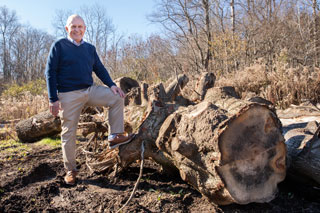
Ridgway chainsaw artist Joe Dussia will be carving a panther statue for the University of Pittsburgh at Bradford from large pin oak trees felled for the construction of its new Engineering and Information Technologies building.
Carving will take place beginning at 10 a.m. Tuesday, Nov. 16, and lasting until 3 p.m. daily for three or four days until the Panther is completed.
The public is welcome to watch Dussia work in the Dorothy Lane parking lot of Blaisdell Hall on campus near the Richard E. McDowell Community Trail.
The wood for the new panther statue, which will find a home inside the atrium in the new Engineering and Information Technologies building, came from trees planted when Pitt-Bradford moved into its current home in the early 1970s.
The idea to use the trees for a new campus landmark was that of alumnus Ron Orris, who is also the executive director of the Blaisdell Foundation in Bradford, which also made a gift to cover the cost of the carving.
Dussia said that making carvings from felled trees is not uncommon. “People can be sentimental about a tree,” he said.
However, it will make from slower carving than what one would see in a competition. Dussia spent part of last week sharpening his saws to bite into the harder wood, which will also much longer to carve than his usual medium of ponderosa pine.
“It’s just more work every which way,” he said of using oak. “But it makes it kind of nicer, too. It holds the detail better.
“I’m real blessed to have this opportunity,” he said. While most of his art ends up in private homes, he likes the thought that this work will be on public display.
Dussia and his wife, Zoe, are both award-winning chainsaw carvers. In fact, she was the person who introduced him to the unique art form.
Joe Dussia said he had always dabbled in art a bit, especially airbrushing motorcycles, so while he was out cutting firewood in Elk County, he stopped at the Chainsaw Carving Rendezvous, an annual weeklong gathering of chainsaw carvers in Ridgway, to watch people carve.
“I thought, man, I like chainsaws, I like motors, and I just started tinkering with it,” he said. He also really liked one of the carvers he had watched, Zoe Boni, whose family founded the rendezvous. “I really thought Zoe was a pretty cool girl.”
He followed up with her to get some tips from her, and she introduced him to some of the smaller saws artists use to cut finer details.
“I was like, this was my girl. This is the girl I’m gonna marry for sure,” he said.
While their romance progressed, so did Joe’s carving. “Around the time that I got involved in chainsaw carving, I saw a mountain lion in the forest around Ridgway. I was all wound up about,” he said. He began carving mountain lions one after another, trying to make each one better than the last. In competition, he often carves a mountain lion, sometimes with an eagle, a second specialty animal that he has picked up skill for along the way.
The Pennsylvania mountain panthers like the one Joe Dussia saw also go by the names of cougars, pumas and mountain lions. They are the inspiration for the University of Pittsburgh’s panther mascot (as well as that of another in-state rival in State College). When it was founded in 1963, Pitt-Bradford kept the panther mascot as its own, while other Pitt regional campuses adopted their own big cats – the University of Pittsburgh at Johnstown Mountain Cats and the University of Pittsburgh at Greensburg Bobcats.
Dussia’s chainsaw-carved panther will be the second created for the campus. For Pitt-Bradford’s 50th anniversary in 2013, the Student Government Association commissioned a bronze panther statue by Bradford native and western artist David Hodges, which sits in front of the Frame-Westerberg Commons.
--30--